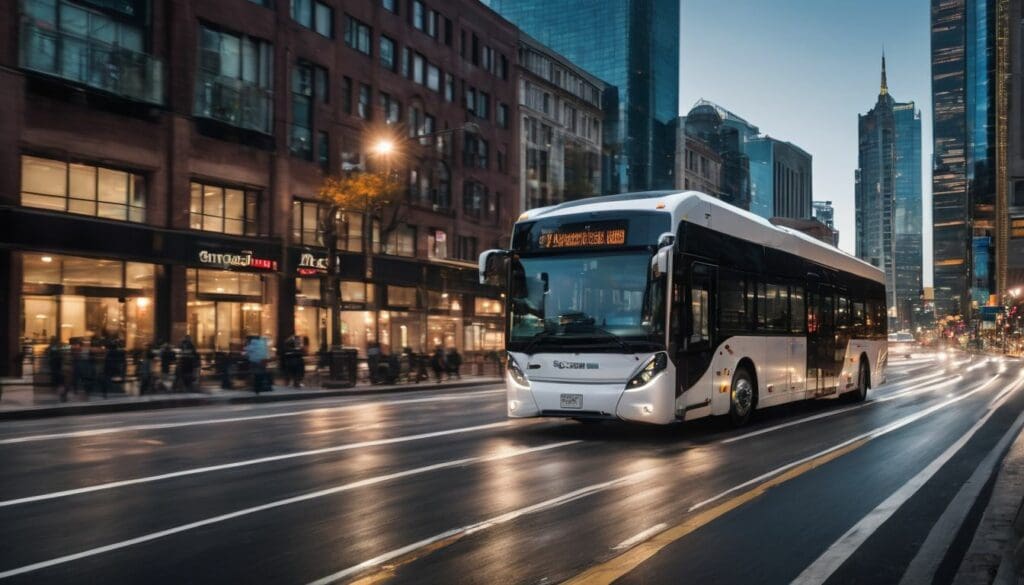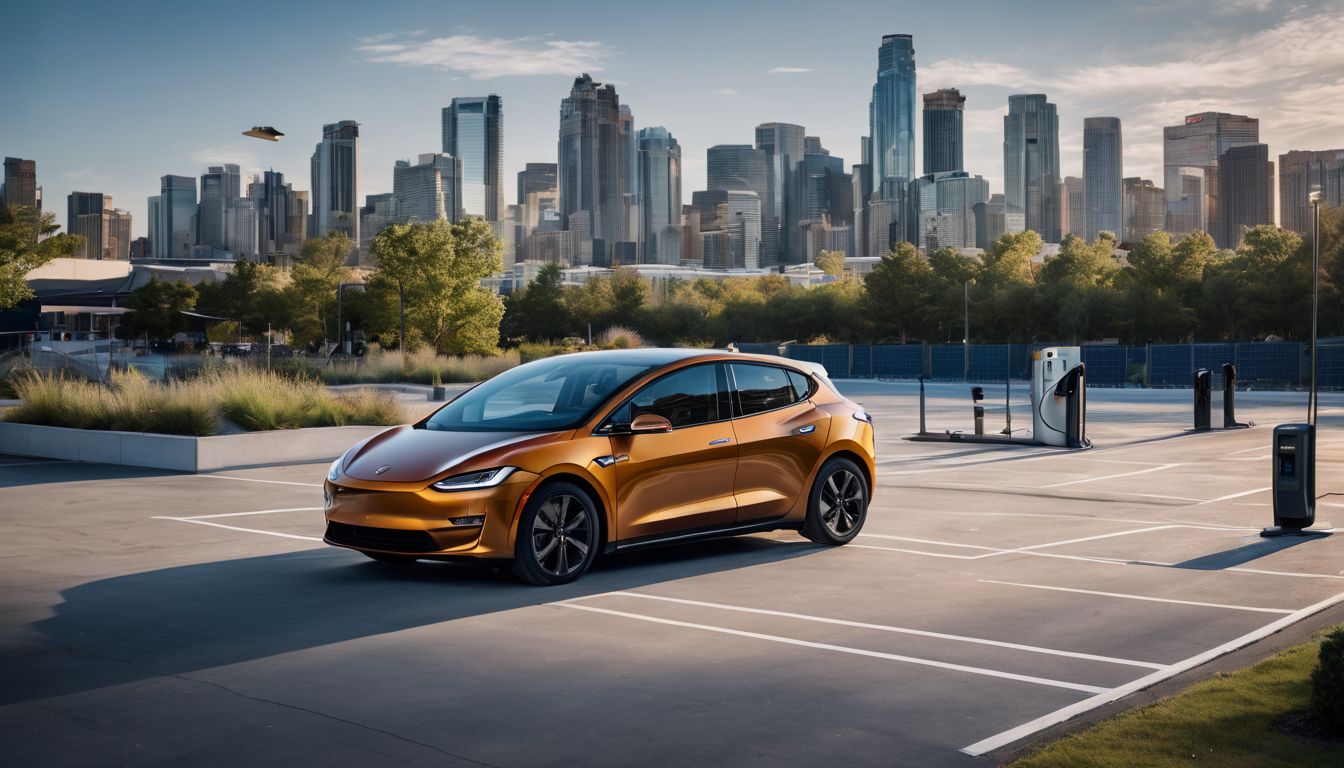We’re all acutely aware of the pressing need to confront the escalating challenges posed by pollution and climate change. Like you, we feel a shared responsibility to seek out means of transportation that are kinder to our planet whilst still reliably delivering us to our destinations.
Our ventures into the realm of sustainable public transport have unearthed some encouraging findings: its widespread adoption has the potential to reduce annual greenhouse gas emissions by an impressive 37 percent.
This article aims to illuminate the route towards more eco-friendly travel practices, demonstrating how seemingly minor adjustments can culminate in significant environmental benefits.
So let’s embark on this journey together – one where each step forward is a breath of fresh air for our Earth.
Key Takeaways
- Electric and hybrid buses are becoming more common, reducing emissions and creating cleaner rides for passengers.
- Smart technologies in public transport allow for real-time updates, better routing and help connect different modes of sustainable transport.
- Bike – sharing schemes and carpooling apps encourage people to use fewer private cars, leading to less pollution.
- Investments in renewable energy – powered light rail networks inspire a move towards efficient public transportation systems.
- Governments play a key role by providing funding and support for the development of eco – friendly transit options.
The Shift towards Sustainable Public Transportation
The push for sustainable public transportation is gaining momentum, with a focus on using clean fuels and renewable energy sources, as well as innovative and intelligent mobility solutions.
Investments in public transportation upgrades are also contributing to this shift towards a more eco-friendly transport system.
Use of clean fuels and renewable energy
We’re embracing clean fuels and harnessing the power of renewable energy to revolutionise sustainable public transportation. Electric buses and trains are hitting the streets and tracks, slashing emissions and offering a quieter, cleaner ride for everyone.
By tapping into electricity from sources like wind, solar, and hydro, we ensure our commutes aren’t just eco-friendly but also incredibly efficient.
Switching to low-carbon transportation isn’t just about upgrading vehicles; it’s a commitment to environmental responsibility that drives us towards greener cities. Utilising innovative mobility solutions helps reduce our carbon footprint while providing reliable options for daily travel.
As more eco-conscious consumers choose electric or hybrid options over traditional petrol or diesel engines, we collectively step forward into a sustainable future marked by zero-emission public transit.
Innovative and intelligent mobility solutions
Innovative and intelligent mobility solutions are revolutionising public transportation. These include advancements such as electric buses, which help to reduce transportation emissions and reliance on fossil fuels.
Additionally, the integration of smart technologies in public transit systems allows for real-time tracking, efficient routing, and improved connectivity with other modes of sustainable transport.
Such innovations not only contribute to cleaner and greener urban environments but also provide more reliable and convenient options for commuters seeking eco-conscious transportation alternatives.
Furthermore, the introduction of shared mobility services like bike-sharing schemes and carpooling apps promotes a shift towards more sustainable transport choices. These initiatives encourage reduced private vehicle usage while enhancing accessibility to environmentally responsible transit options in urban areas.
Investments in public transportation upgrades
Investments in public transportation upgrades play a crucial role in shaping sustainable urban mobility. Upgrading existing transit systems with energy-efficient technologies and infrastructure, such as electric buses and renewable energy charging stations, contributes to reducing carbon emissions and offering ecofriendly transport options.
By investing in the expansion of bicycle lanes, pedestrian-friendly pathways, and efficient bus rapid transit (BRT) systems, cities can promote sustainable transportation solutions that benefit both the environment and the community.
Efforts to enhance public transportation continue to drive progress towards greener urban landscapes. Embracing these advancements will lead us toward a future where sustainable transportation is accessible for all, furthering our commitment to ecoconscious living.
Benefits of Sustainable Public Transportation
Sustainable public transportation offers numerous benefits, including the reduction of carbon emissions and pollution, providing affordable transportation options for all individuals.
Making use of renewable energy sources and clean fuels also contributes to a healthier environment.
Reduced carbon emissions and pollution
Reduced carbon emissions and pollution are crucial benefits of sustainable public transportation. By using clean fuels, such as electricity from renewable sources, and implementing zero-emission vehicles in ecofriendly public transit systems, we can significantly decrease the environmental impact of transportation.
These efforts play a vital role in creating energy-efficient public transportation that supports conservation and environmental sustainability.
Affordable transportation options also contribute to the reduction of carbon emissions and pollution, making ecoconscious transportation accessible to a wider population. Investing in green transportation not only improves air quality but also fosters a healthier environment for everyone.
Affordable transportation options
Transitioning from reducing carbon emissions and pollution, we must also consider affordable transportation options. Embracing sustainable public transit not only benefits the environment but also provides cost-effective travel choices.
By investing in clean energy buses, modernising light rail services, and promoting bike-sharing schemes, cities can offer affordable commuting alternatives while reducing their carbon footprint.
Eco-friendly transportation initiatives such as electric buses and efficient mass transit systems alleviate the financial burden on individuals while contributing to a healthier planet.
Challenges and Opportunities for the Future of Sustainable Public Transportation
The challenges and opportunities for sustainable public transportation are vast. With the need for government support and funding, as well as technological advancements, the future of sustainable public transportation holds great potential for creating a cleaner and greener environment.
Need for government support and funding
Government support and funding are crucial for the future of sustainable public transportation. By allocating resources to develop eco-friendly transit systems and renewable energy vehicles, governments can accelerate the shift towards low-carbon transportation.
This assistance is essential in implementing BRT systems, promoting energy-efficient public transportation, and making clean and green transit more accessible for all.
Furthermore, government backing enables the advancement of technological solutions for sustainable transport. It facilitates research into innovative mobility options, ensuring that zero-emission public transit becomes a viable choice for communities.
Technological advancements
Technological advancements in sustainable public transportation are driving positive change. Innovative developments, such as electric and hybrid buses, are revolutionising the transport sector.
These energy-efficient vehicles run on clean fuels, reducing carbon emissions and enhancing air quality in urban areas. Additionally, smart technologies like real-time tracking and route optimisation systems improve operational efficiency and passenger experience, making public transport more convenient and appealing.
Furthermore, advancements in renewable energy integration with public transportation systems are creating a low-carbon future for cities worldwide. Solar-powered charging stations for electric buses and trains harness sustainable energy sources while minimising reliance on non-renewable resources.
Conclusion: Making a Better Tomorrow Together
The future of sustainable public transportation looks promising as we embrace clean fuels and renewable energy. Innovative and intelligent mobility solutions are shaping the way for eco-friendly transportation options.
With investments in public transportation upgrades, we can look forward to reduced carbon emissions and a healthier environment. Challenges exist, but with government support, funding, and technological advancements, we can pave the way for a brighter and more sustainable future for public transit systems.
Let’s work together to make this vision a reality.
FAQs
1. What does sustainable public transportation mean?
Sustainable public transportation refers to eco-friendly means of transit that use renewable energy, aim for low carbon emissions, and focus on being energy-efficient to protect the environment.
2. Why is sustainable transport important for our future?
The importance of sustainable transport lies in reducing pollution and conserving resources, leading to a healthier planet with reduced climate change impacts through zero-emission public transit options.
3. Can you give some examples of sustainable transportation trends?
Examples of current trends include electric buses using renewable energy sources, bike-sharing schemes promoting low-carbon travel, and high-speed trains that offer efficient alternatives to car or air travel.
4. How will future developments in sustainable mobility affect how we travel every day?
Future advancements in sustainable mobility promise more accessible and reliable eco-friendly transportation choices that align with growing environmental consciousness and the desire for cleaner cities.





